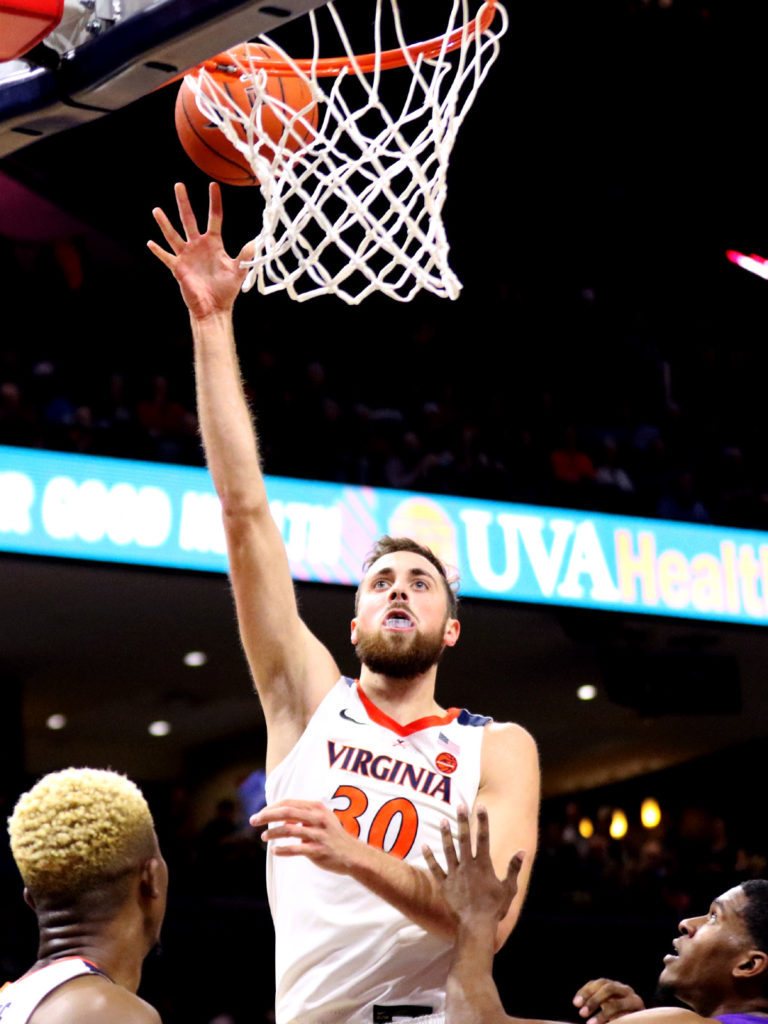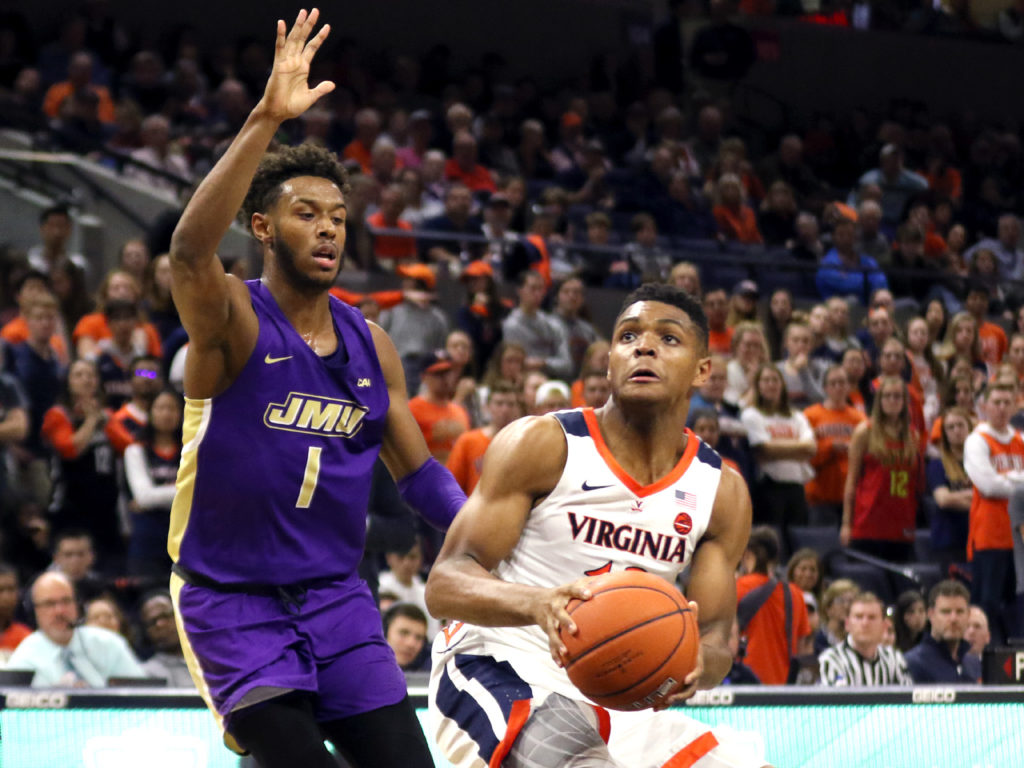The Virginia men’s basketball team remains undefeated after another defensively dominant game on Saturday afternoon. The Cavaliers’ defense is prominent even before they step on the court, as opponents fear the Pack Line before games even begin. However, the Cavaliers’ offense quickly made a name for itself against Columbia. The Hoos instantly ignited some heat as they began with a 10-0 lead. While this is exciting, let’s take a closer look at the details of the last victory.

Size Matters
An advantage for the Hoos in the early wins, particularly the past two games, has been their height difference over opponents. Jay Huff is quite literally a big part of this success. The 7’1” redshirt junior scored in double figures in all three games and contributed six rebounds and five blocks against Columbia. He wasn’t alone in this effort though. Opponents have gone up for shots 19 times in three games only to then have them smacked down.
Not only did this height difference contribute defensively, but also offensively. Six-foot-nine redshirt senior Mamadi Diakite joined Huff in scoring the lucky number 13 points in last Saturday’s win. Virginia holds a 96-48 advantage in points in the paint through the first three games. This breaks down to UVA 26 Syracuse 16, UVA 40 JMU 6, and UVA 30 Columbia 16.
Virginia’s height advantage over James Madison and Columbia was clear. JMU had no players taller than 6’8” and Columbia only had two. Virginia has four. Given the height disparity the Cavaliers were bound to have success on the boards, which is exactly how things played out. Virginia outrebounded JMU 50-36. While it was a bit surprising to see Virginia only outrebound Columbia by five, Huff’s defense erased most breaks the Lions had towards the basket.
Opponents and their drives will change, but Huff’s height is here to stay.
Young Hoos Struggling From Three
Trying to fill the outside shooting accuracy of Kyle Guy, Ty Jerome, and De’Andre Hunter has proven to be a challenge for this Virginia team. The Cavaliers are currently last in the ACC in 3s per game (4.3) and 348 of 350 in the NCAA in 3-point percentage (20%).

Freshman Casey Morsell was speculated to potentially fill this hole, along with sophomore Kihei Clark. They have both been attempting to step out and shoot a few more 3s when they have the liberating opportunity, but unfortunately failed attempts can lead to discouragement. Clark is currently only 5-of-16 from 3 and has only taken nine shots from inside the arc. Morsell demonstrated the ability to shoot in high school, but the intensity is entirely different in college ball, let alone the ACC.
While the statistics may seem scary and drastically different from last season, they’re hardly a novelty. Take a look at the numbers of former Virginia true freshmen guards and their first few games, and there’s a trend.
In Ty Jerome’s first three games, he was 0-3 from outside the arc. He shot 36% from the 3-point line from only 14 3s over the nonconference in his first year. Kyle Guy went 3-4 from 3 in his first three games, but then he went on to hesitate with his own confidence as he did not even attempt a single 3 against St. Francis Brooklyn, and only shot one against UNC Greensboro. Look where the two are now. The primal hesitation didn’t last long with them and probably won’t this year, either.
If this doesn’t have you convinced, then let’s take it back farther. In London Perrantes’ freshman season, he only had 12 points throughout his first five games. This included a 2-of-12 start from 3. He played on what could arguably be one of the most talented rosters for Virginia, and didn’t start his first three games. His lack of early success on a team with extreme skill is quite mirroring of this year’s situation, so don’t start stressing too early.
Hopefully, as the season advances, so will these players. Clark and Morsell have already exemplified sparks, beginning to ignite some electricity. Clark had an excellent ball fake on a drive against Columbia point guard Mike Smith, who is the most notable player on the Lions. It’s moves like these that illustrate offensive strategy that will lead into shooting and its improvement. Morsell also began to drive a bit more, which is hopeful for his confidence and the efforts from the freshman as a whole.
Defense, Defense, and More Defense
For the first time since 1948, the men’s team has held its first three opponents under 50 points. As exemplified in the Columbia game specifically, opponents simply struggle to get uncontested shots. JMU scored at least 70 points in every game before facing the Hoos, and Columbia shot 41% against opponents until Virginia. On Saturday, they shot 29%.
Tony Bennett and his Pack Line defense forced the Lions to shoot from outside the arc. Thirty-eight percent of their shots were 3s, and then they could only make six of them, which ended up accounting for 43% of their total points.
It’s not just the shooting where opponents fail, but also the ballhandling. Virginia forced double-digit turnovers against both Columbia and JMU, while Syracuse had nine. After just three games, that’s 42 turnovers for opponents facing Virginia. One word for the Cavaliers’ defense? Forceful.
While the Hoos are enjoyable to watch, what might be just as entertaining is people upset with how many points the Cavaliers gave up to Columbia. Yes, Columbia scored more points than previous opponents. But how many did they score? Forty-two. Forty-two points on the board. Only 17 in the first half. Sure, the Cavaliers surrendered more than the 34 points allowed in each of the previous two games, but this 6-point increase – while maybe not aesthetically pleasing to some – is the least of my worries.
While I cannot emphasize the dominance of the defense enough, Virginia is averaging 57.7 points per game. Should this be a concern? Hardly. Virginia leads in scoring defense (36.7 PPG). The Cavaliers are also winning by an average of 21 points. Don’t let the inevitable outsider fear and gossip wreck the understanding of how this team will be successful.
The Cavaliers look bigger and stronger than opponents. The 3-point shooting needs immense improvement; however, there remains great hope for the Hoos.




Yep, a Tony, Double Tony and Reverse Tony.